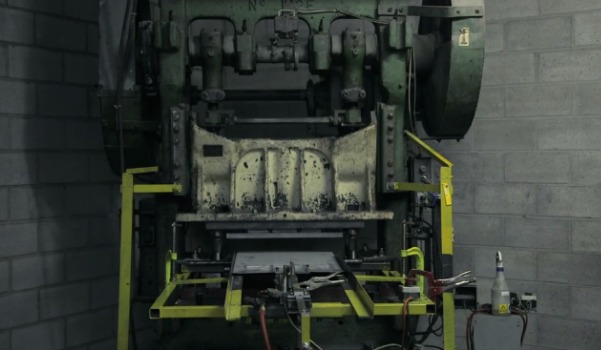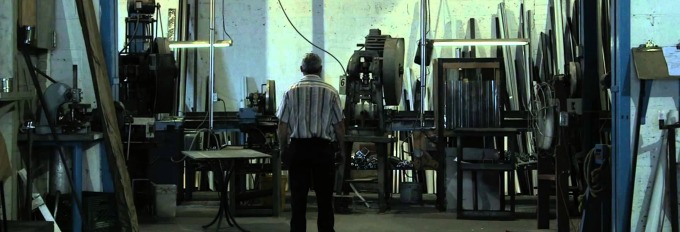JOY OF MAN’S DESIRING could very well be a modern-day Charlie And The Chocolate Factory. Leading us through the pipes and backrooms of a tangle of workplaces and warehouses, Côté’s directorial eye lays bare a world just as alien, just as savagely alive, as that of the Oompa Lumpas, the chocolate river and the Juicing Room. Desire runs thickly through every rotation of the piston, through every tapping of treacly excess. It is dark and heavy, its destructive potential building in the claustrophobic hum of the machines. The factory space becomes a pressure-cooker of capped wants and lusts. The feeling of immanent and catastrophic rupture lurks within the repetitive lethargy of the machinery throughout, and it is all so wonderfully terrifying.
The hybrid composite of the film marries documentary footage – long, persistent takes of machines in motion, hands sorting robotically – with more experimental dialogues and monologues between workers. The first image is that of a woman speaking to an unknown recipient, laying down the terms of a relationship both forcefully and intimately. Her face becomes a spectral déjà-vu throughout the film, her presence haunting other workers in a way that nurtures as much as it bullies. When she speaks to one of her colleagues – “I get the feeling that you and I don’t talk much anymore!” – her words negotiate a dystopian future already a physical reality in the factory space in which the human is channelled differently, communicates differently. His sexuality, like his language, runs through the mechanics, radically intersubjective and disembodied, alluring and virile. It is impossible not to be wooed by the hypnotic flirtation of the machinery. The film’s opening credits run over the image of a piston rotating in a figure of eight, its movements obscenely voluptuous and sleazy. The factory, like the film, doesn’t speak much. It teaches us to desire differently, to think about our bodies and their adjacent parts in the plural and the continuous.
The imagery is beautiful. It is extra-terrestrial, like glimpsing the bottom of the ocean or exploring the set of The Clangers.
The film’s greatest achievement lies in its locating and inhabiting a disjoint between space and time particular to the factory. Only fleetingly does the camera happen upon the outside world – a group of workers smoking on a balcony framed by a doorway, a window too high up to see out of – preferring the in-between non-space of the warehouse. The complete absence of linear narrative echoes the factory’s rejection of chronology. The split agonies of the workers, simultaneously longing to stop their work and passionately being married to it, dislodges temporal landmarks of past and future, allowing only the restless charge of the present. A child stares playfully at the camera in a workshop whilst others move around her, seemingly oblivious. Two men lie on the floor emotionless, their poses almost funerary yet their conversation voicing only the impossibility of stopping work. Seasonal landscapes are replaced by deserts of metal and wiring. The factory is revealed to be a fantastical, fictional space outside of time, inserted eerily within the real world. The instruments of its imaginary, however, are exhilaratingly physical and active, constantly producing, desiring, operating.
There is an unmistakable yet foreboding hospitality to the factory, an atemporal Stockholm syndrome which promises warmth and sustenance outside of political chronologies and agendas. Whilst the factory bullies and abuses, it also liberates. One worker exclaims “I sit at my machine, I move to its rhythm, I just go with it.” This sense of abandoning oneself to the non-human, of allowing it to take over, is tangible within the camerawork which loses track of itself, resting on the same piece of machinery for vast expenses of time, moving with it, at times becoming carried away with a sudden, lurching zoom. The imagery is beautiful. It is extra-terrestrial, like glimpsing the bottom of the ocean or exploring the set of The Clangers. One particularly arresting shot follows two workers as they unwrap a large block of foam. As the plastic wrapping falls away, the foam expands and takes on new shapes, as if reacting warmly to its new environment. Another shot stays focused upon three large barrels which take it in turns to explode, casting around them barrel-shaped envelopes of grey dust. This visually monstrous cast of machines and surfaces provides the perfect setting for the rootlessness of the workers who speak with a variety of accents, who communicate through stops, starts and muddled gestures, but never talk of origin – “when we arrived here…” – only movement. Set in motion here, quite literally, is a radically rhizomatic, post-colonial living space.
The film closes with a boy playing a violin within the factory. The moment feels jarring and out of place; an ugly nostalgia within the atemporal imaginings of the workspace. It feels almost like a mocking ode to old embodiments of desire and entertainment, a sharp reminder of what we have been forced to leave behind throughout the film as well as the realisation that maybe leaving it behind was easier than we might have expected. At its best, Denis Côté’s hybrid film negotiates a space of production for post-human narratives and post-human audiences.
httpvh://youtu.be/jIaWeSRqNAg


